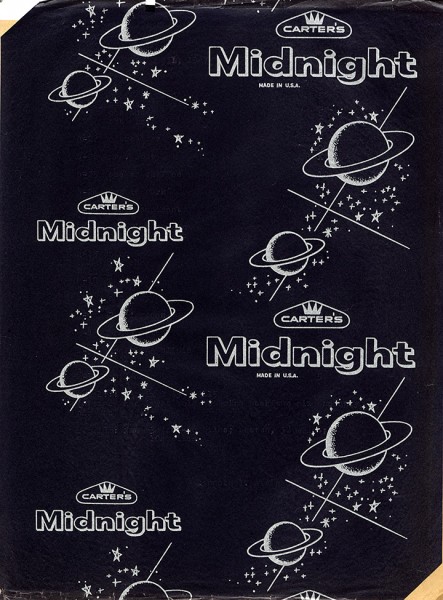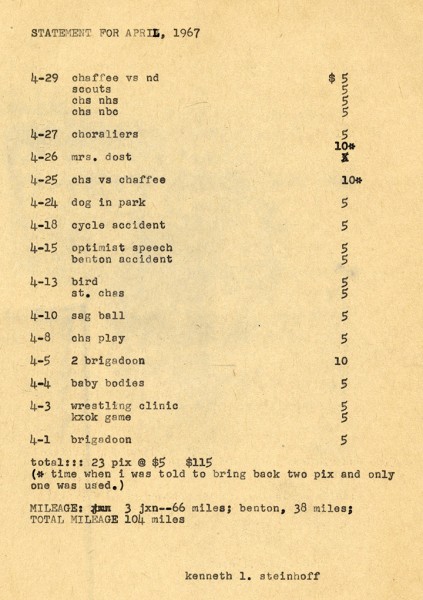 There, stuffed in between some folders of yellow memos and letters was something I haven’t touched in at least 20 years: two sheets of Carter’s Midnight carbon paper “Made in U.S.A.” These particular two sheets have to be almost 47 years old, because one of them had made a copy of my April 1967 Missourian photo invoice and mileage sheet.
There, stuffed in between some folders of yellow memos and letters was something I haven’t touched in at least 20 years: two sheets of Carter’s Midnight carbon paper “Made in U.S.A.” These particular two sheets have to be almost 47 years old, because one of them had made a copy of my April 1967 Missourian photo invoice and mileage sheet.
Not a bad haul
 I billed $115 for photos for the month of April at a time when I might have been raised from $50 a week to $60 or $70. Bringing home about a hundred bucks a week was pretty good when I was living at home and my only expenses were gas, photo supplies, eating out and squiring future Wife Lila around (she’ll testify that not much was spent on that). I see I made a mistake on the original, but didn’t bother to correct it or make the carbon copy line up.
I billed $115 for photos for the month of April at a time when I might have been raised from $50 a week to $60 or $70. Bringing home about a hundred bucks a week was pretty good when I was living at home and my only expenses were gas, photo supplies, eating out and squiring future Wife Lila around (she’ll testify that not much was spent on that). I see I made a mistake on the original, but didn’t bother to correct it or make the carbon copy line up.
Other things I don’t miss
- You can still buy carbon paper on Amazon
- If you had to make several copies, you’d use think “onion skin” paper
- I never liked the liquid paper version of White Out. I’d get it on too think and it would either peel off or gum up the keys.
- Life got a lot better when correction tape came along
- Typewriters are dead, but there is still a demand for eraser pencils. I just ran across one the other day; they’re great for cleaning battery terminals.
When Grandson Malcolm and his friends stay overnight in a few weeks, we’re going to introduce him to the magic of carbon paper.

I never did get carbon paper right and white out was just a mess. Onion skin,was not much better,either!
Ken, I looked up your picture from the Choraliers assignment of April 27, 1967. It showed the director, Jack Palsgrove, with others preparing for rehearsal.
Here is the blog I made about the Choraliers’ trip to the World’s Fair in 1962. It has several pictures and a story by Jo Ann Bock.
http://www.semissourian.com/blogs/flynch/entry/48090/
And let’s not forget another ancient method of duplicating: the Ditto Machine. You’d type your manuscript onto a Ditto Master, comprised of the top sheet and a sheet full of some inky stuff beneath. Then you’d peel off the top, affix the inky page to a cylinder, and hand-crank the Ditto Machine until a sufficient number of copies were made. They were wet, smelly and smeary, but that’s how teachers in the Fifties and Sixties mass-produced worksheets and tests for their students. Anyone else remember those days??
Who can forget that sweet smell?
Dad had a mimeograph machine for making forms and the like. THOSE things were worse than carbon paper. If you made a mistake on the template, you had us use a liquid that would fill in the error, wait for it to dry, then get the sheet lined up exactly right before starting again.
Dad was a big one for creating custom forms. I’ve often wondered what he would have done with computer graphic programs and AutoCAD and Excel. He’d have been in hog heaven.
When Railroad Operators copied Train Orders dictated by the Dispatcher, they used two or more layers of translucent paper train order forms (sometimes called flimsies) with double-sided carbon between and wrote on the top layer with a sytlus.
The top train order form had the writing on the back and the rest had writing on the front side as result.
Many model railroaders follow that same practice today if they operate their railroad on Timetable/Train Orders with a Dispatcher and Operator as the prototype did.
After I returned from Viet Nam they made me an Operation Sargent for a training company at Ft Leonard Wood. You had to do reports that went up to Brigade Headquarters every morning. They had to have 7 or 8 copies of the report and of course it required using carbon paper. Since I had NEVER typed before I used the 2 finger hunt and peck system which was not very efficient or user friendly. I made so many mistakes and would try to correct them to no avail. The top copy usually wasn’t to bad because of the correction tape on the ribbon. The copies behind the carbon paper were a different story. The waste basket was full of paper and carbons by noon. I would finally get one that I thought would get by the Sargent at HQ and then try to take it up to him when I thought he would not be at his desk. He was usually there and he would look at the report, shake his head and tell me to do it over. I hated that walk every morning.
I put so many holes in the template using the mimeograph correcting my mistakes and had to redo them so many times, it really got old. Of course the columns and lines were never straight when I finished. At least I could get by with them being messy as they were only new class rosters and no one cared to much.
The Army decided after I had been doing this job for 8 months to send me to typing school. Of course the school was for 2 months and I had only had 3 months left in the service so I didn’t get to go and still use 2 fingers to type although I am a little faster.
Ken,
Remember at the bottom of typed page, or letter, there was a cc:, for carbon copy to someone. Now, the cc means courtesy copy, as carbon paper is almost history.
Thanks,
Jim Pierce
I’ve tried to put carbon paper out of my mind, so all I know after reading this particular submission is, wow Ken, you were living pretty large at $5 per picture. I don’t think I made $115 in a year back then, whatever job I had at the time.
Walter, well, out of that $5 I had to pay for my film, paper and chemicals. Still, I was making so much that John Blue cut me back for awhile by paying $5 for assigned photos and $3 for self-generated art. That didn’t last too long because sympathetic reporters would “assign” me to shoot some of the stuff I showed them.
It was a pretty good deal all around: The Missourian got somebody who would roam the city at all kinds of hours, and I got paid for something I’d have done for free. What I banked from newspaper pay let me coast through my first year at Ohio University before I started working for The Athens Messenger. I never got rich working for papers, but I could always buy a hamburger.
My computer went down not long ago. I had something I wanted to email out right away so did the next best thing … got out my old Sears & Roebuck typewriter. Much to my surprise the ink ribbon still produced and I was able to get the item typed and snail-mailed out. I also found a package of carbon paper that would have worked but I opted to copy the typed information via my printer. That was a trip back in time and my fingers were quite tired and sore after having to hit the keys so hard! Thank goodness, the old crusty bottle of white-out still worked too!